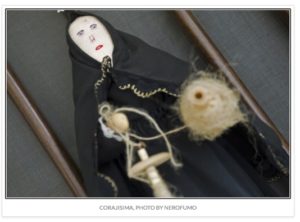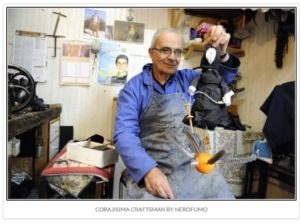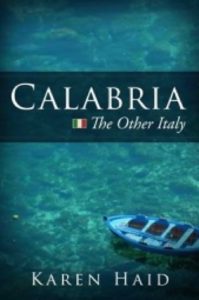Lent in Italy – Corajisima, A Calabrian Tradition
This article is from Calabria: The Other Italy. Check out this website to see additional information and pictures:
If you happen to be celebrating Easter in Calabria and you arrive a little early, you may just come across what looks like a ragdoll hanging from a balcony or the side of a house. Not to panic, this is not some form of malocchio or evil eye, but Corajisima, a traditional practice during Lent in Italy, specifically, Calabria and other areas of the south.

WHAT IS CORAJISIMA?
Corajisima is more a who than a what. She is the wife or perhaps more accurately said, the widow, of Carnevale. She can also be called the sorella or sister of Carnevale. After the great feast of Martedì Grasso or Fat Tuesday, Carnevale, the embodiment of the revelries, dies. Poor Corajisima remains alone. Usually depicted as an ugly, skinny old woman with a decidedly unsettling appearance, she represents abstinence in the Lenten period.
In some towns, Corajisima starts out immediately after midnight of Martedì Grasso, roaming the streets and setting out pots full of boiling water to burn the throats of whoever dares to eat meat during Lent. Just the mere thought of such a horror has been known to scare children away from sweets for a good long time.

In the town of Palmi, for example, the children chant these verses:
Calabrian
Coraisima cu’ lu fusu
Quandu cadi si rumpi lu nasu
Si lu menti ‘nta pertusu
Coraisima cu’ lu fusu.
Italian
Quaresima col fuso
Quando cade si rompe il naso
lo nasconde in un buco
Quaresima col fuso.
English
Corajisima with the spindle
When she falls she breaks her nose
She hides it in a hole
Corajisima with the spindle.
WHAT IS QUARESIMA?
Quaresima is the word used for Lent in Italy, or the forty days between Carnevale or Mardi Gras and Easter. It’s the period of abstinence that seems to never end, judging by the Italian expression, “essere lungo come la quaresima” (literally, to be long like Lent).
Quaresima comes from the Latin quadragesima and in addition to Corajisima has also been transformed to Curemme, Quarjisime, Quarajìsima or Quaremme in various Calabrian dialects. Needless to say, it isn’t a compliment when the word pops up in the description of someone, such as in these proverbi calabresi (Calabrian proverbs) in calabrese(Calabrian), italiano (Italian) and English:
Si chiù longu de corajisima.
Sei estremamente lento nel fare le cose.
You do things very, very slowly.
Pari na corajisima.
Sembri una Corajisima.
You look like a Corajisima. (In other words, old and wizened)
LENT IN ITALY – STILE CALABRESE (Calabrian Style)
Figures of Corajisima, a woman who’s clearly seen better days, appear on Ash Wednesday. They dangle from windows, balconies, doorways, chimneys, laundry lines, or anywhere else they’ll hang. Usually clothed in long black dresses with white faces whose eyes, nose and mouth are embroidered in black thread, the Corajisimaholds a spindle and distaff in her hands, the thread between them representing the forty days of penitence, such as doing without meat and avoidance of culinary excesses, sober conduct and even conjugal abstinence.

Corajisima usually stands on an orange, lemon or potato with seven feathers attached. One feather is removed each week after Sunday mass, with the last being taken away on Easter morning. The joyful ringing of church bells on Pasqua (Easter) signals the end of repentance and the return to good living as in this Calabrian proverb:
Gloria sonandu campanara mangiandu.
Gloria suonando, dolci mangiando.
Glory ringing, sweets are eaten.
NATURE AND TRADITION
Lent in Italy and many of its accompanying rituals connect historically with ancient pagan observances. In tune with the rhythm of nature, Corajisima is tied to the cycle of the seasons, as in the reawakening of the earth for the arrival of spring. For instance, in the mythology of Greater Greece that flourished throughout Southern Italy, the end of winter coincided with the goddess Persephone coming out from the underworld as the personification of vegetation. The Romans called her Proserpina. This precarious time anticipating the rebirth of the natural and spiritual worlds has found its expression in a simple, handmade doll with fruit, feathers and spinning tools attached, all full of symbolism and a way to persevere until the arrival of spring and the resurrection.
These sad, scary ragdolls aren’t as easy to spot as they once were. The tradition has all but died out in many towns and villages, but in the past few years, there has been a resurgence of the custom. And of course there are always variations, such as the use of an onion or a caciocavallo(a semi-hard cheese resembling a sack on a string) in which to stick the chicken feathers, or perhaps with a modern doll or even without.

But as delightful a tradition as it is, the coming of spring and Easter will always be a relief, as in this old saying that expresses the less-than-ideal situation when in the presence of Corajisima.
‘U ventu ‘no volava, ‘u mari ‘no vagava, Corajisima aspettava.
Il vento non volava, il mare non bagnava, mentre Corajisima aspettava.
The wind wasn’t blowing, the sea wasn’t lapping while Corajisima was hanging around.
Thus, Buona Pasqua (Happy Easter) and Bentornata Primavera (Welcome Back, Spring)!
Article by Karen Haid.
Photos are courtesy of Nerofumo.

Interested in Italian traditions and lifestyle? Read more about this fascinating southern region in Calabria: The Other Italy, a nonfiction, award-winning book that explores daily life, culture, history, the arts, food, society and tourism of Calabria, Italy. Available in paperback and e-book versions.
“Like” Calabria: The Other Italy’s Facebook page and follow Karen on Karen’s Instagram and Karen’s Twitter for more beautiful pictures and information.